Coordination of Macro Base Stations for 5G Network with User Clustering
Abstract
:1. Introduction
2. Energy Management Model of 5G Macro Base Station Network
2.1. Communication and Power Consumption Model of 5G Macro BS
2.2. Optimization Step 1: Energy Management of the 5G Communication Equipment
- (1)
- Power consumption constraints of communications equipment:where denotes the power of communication equipment in BS m; and are the power consumptions of the AAU and BBU in BS m, respectively; represents the working status of BS m; BS m is in sleep mode when = 0 and active mode when = 1; is the PA efficiency of the AAU in BS m; Pm,c AAU, Ac and Pm,c AAU, Sl denote the constant parts of the power of AAU in BS m in the active and sleep modes, respectively; and Pm,c BBU, Ac and are the constants of the power of BBU in BS m in the active and sleep modes, respectively.
- (2)
- With the BS in sleep mode and the use of the user allocation method, each user in the network could be served by local or adjacent BSs. However, each user can only connect to one BS at a time, and its QoS requirements should be met. The user allocation constraints are as follows:where denotes the connection relationship between BS m and user ut; user ut is not connected with BS m when , while user ut is connected to BS m when , and represents the set of adjacent BSs of user ut. Equation (11) indicates that user ut can only connect with BSs that are in active mode. Equation (12) indicates that user ut can only connect with one BS at a time.
- (3)
- Maximum data transmission rate constraints of BSs:where Nm denotes the set of users in cell m and its adjacent cells; denotes the total data processing rate of BS m; and denotes the maximum data processing capacity of BBU in BS m.
- (4)
- Maximum transmit power constraints of BSs:where denotes the total transmit power of AAU in BS m; and denotes the maximum transmit power of BS m. The maximum data transmission rate constraints (14) and the maximum transmit power constraints of BSs (16) ensure that all users’ QoS requirement can be satisfied.
2.3. Optimization Step 2: Energy Management of the Standard Equipment in 5G Macro BSs Network
- (1)
- Power balance constraints of 5G macro BSs network:where represents the input power of BS m, which can be either positive or negative.
- (2)
- Power balance constraints of a single BS:where , , and are the charging/discharging power of the backup battery and power of the AC in BS m; denotes the wind/solar curtailment rate of the renewable generation unit in BS m; and and are the given power profiles of the renewable generation unit and communication equipment in BS m, respectively.
- (3)
- AC-related constraints:where is the rated power of the fixed frequency of AC in BS m; denotes the on/off state of AC; represents the equivalent cooling power inside BS m; is the energy efficiency ratio of AC in BS m; and Pother represents the heating power of the other equipment in the cabinet of BS m. represents the indoor temperature; denotes the initial indoor temperature in the cabinet of BS m when t = 1, , and are the preset upper and lower bounds of the indoor temperature inside the cabinet, respectively; and and denote the equivalent thermal resistance and equivalent thermal capacity of the cabinet of BS m, respectively.
- (4)
- Backup battery-related constraints:where and denote the charge/discharge state of the backup battery in BS m; , , , and are the upper/lower limits of the charging power and discharging power of the backup battery in BS m; denotes the energy storage of the backup battery in BS m; denotes the initial energy storage of the backup battery in BS m; denotes the energy leakage coefficient of the battery; is the charge/discharge efficiency coefficient of the battery; and and represent the upper and lower limits of the energy storage of the backup battery in each BS, respectively.
- (5)
- Wind/solar curtailment rate constraints:
3. Problem Reformulation with User Clustering and Benders Decomposition
3.1. User Clustering Strategy for ()
3.2. Benders Decomposition for (P2)
- (1)
- Input the model parameters, initialize the lower and upper bounds of (P2) LB = 0 and UB = ∞, and initialize the number of iterations k = 1;
- (2)
- Check whether the condition pertaining to the number of iterations k ≤ kmax is established. If it is, then go to step (3); if it is not, then the loop ends, and the optimal solution of (P2) fails to be found in kmax iterations;
- (3)
- Solve the MP to obtain the optimal function value and optimal variable values (, , , , and ; let ;Input the value of the complex variables into SP1 and then solve the optimal function value of SP1 and check whether is established; if it is, then add a Benders feasibility cut into the MP, let k = k + 1; if it is not, then go to step (5);
- (5)
- Input the value of the complex variables into SP2, and then solve the optimal function value of SP2; let ;
- (6)
- Check whether the convergence criterion is established. If it is, then the optimal solution of (P2) is found, and the loop ends; if it is not, add a Benders optimality cut to MP, let k = k + 1, and go to step (2).
4. Case Study
4.1. Simulation on 3 × 3 5G Macro BSs Network
4.1.1. System Description
4.1.2. Effectiveness of the Two-Step Energy Management Model for 5G Macro BS Network
4.1.3. Computational Efficiency of the User Clustering Method and Benders Decomposition
4.2. Simulation on 10 × 10 5G Macro BS Network
4.2.1. System Description
4.2.2. Comparative Analysis between the Proposed Dispatching Scheme and the Conventional Dispatching Scheme for 5G Macro BSs Network
5. Conclusions
- The two-step energy management model for communication and standard equipment can effectively reduce the energy consumption and electricity costs of the entire 5G macro BS network compared with the conventional dispatching scheme by making full use of the spatial and temporal fluctuations of the traffic load, the thermal inertia of the cabinets, and the storage of the backup batteries;
- The proposed solution-accelerating methods—that is, user clustering and Benders decomposition—were found to be computationally efficient, while they ensured excellent performance with approximate optimality.
Author Contributions
Funding
Institutional Review Board Statement
Informed Consent Statement
Data Availability Statement
Conflicts of Interest
Appendix A

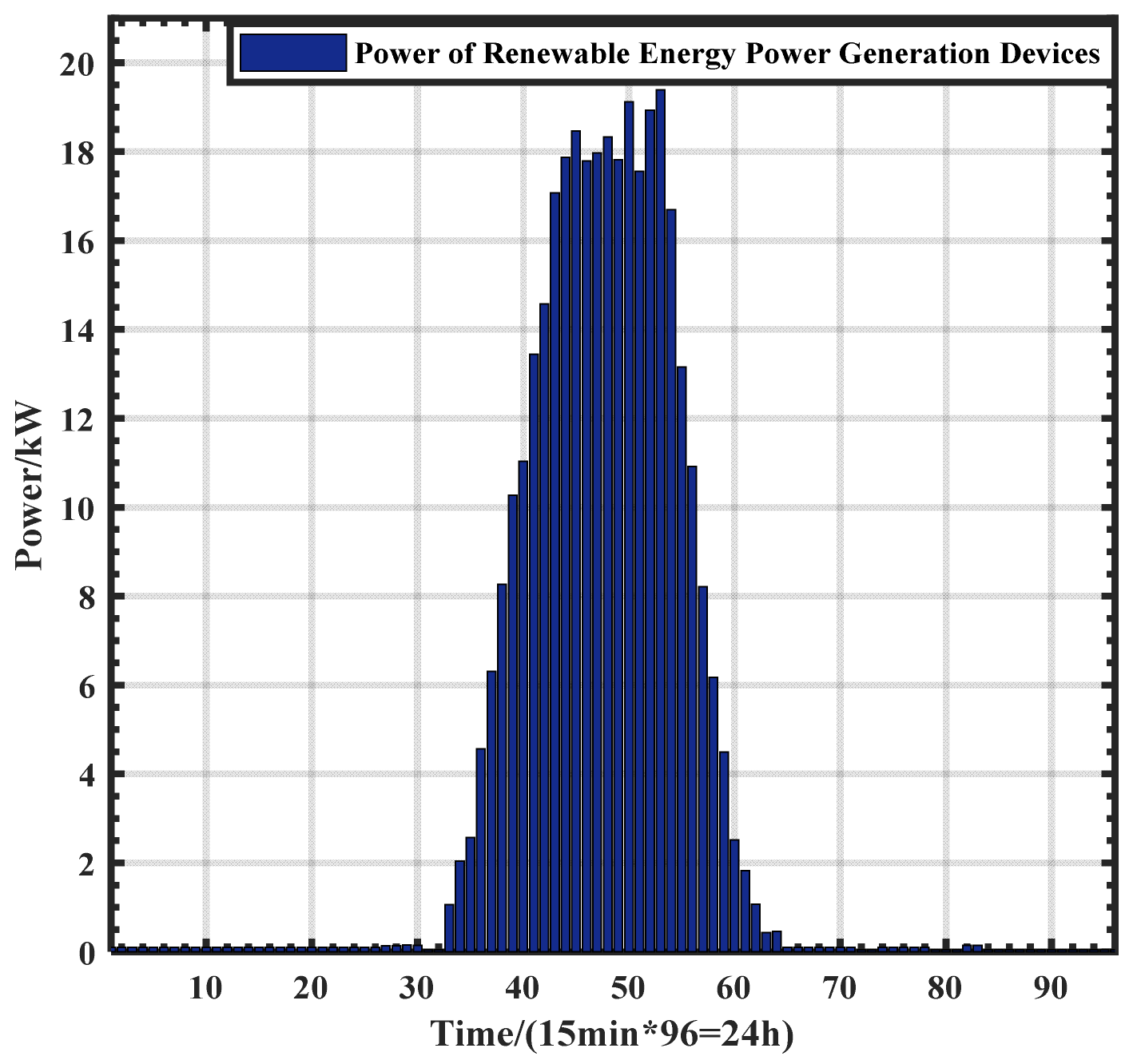
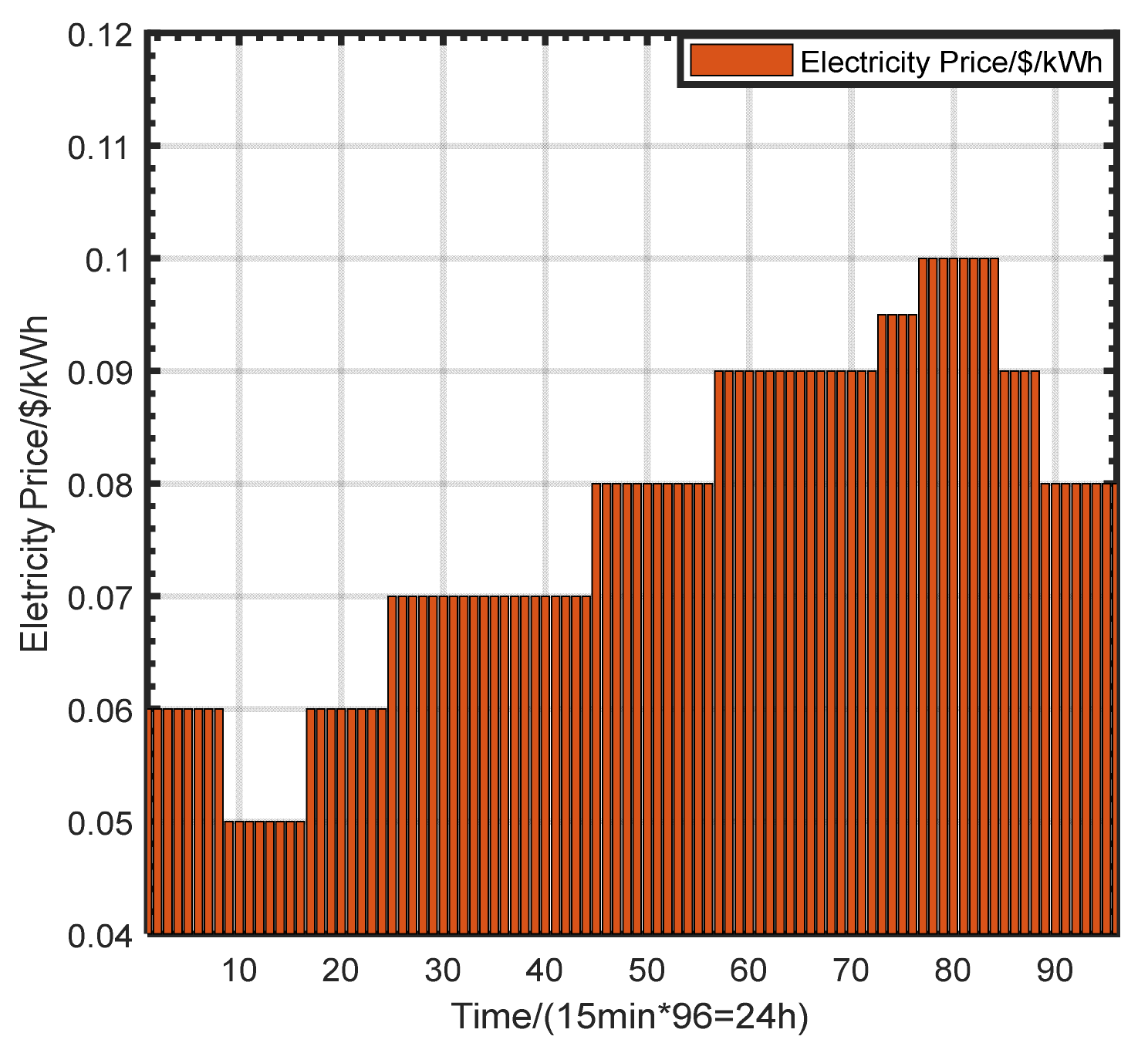

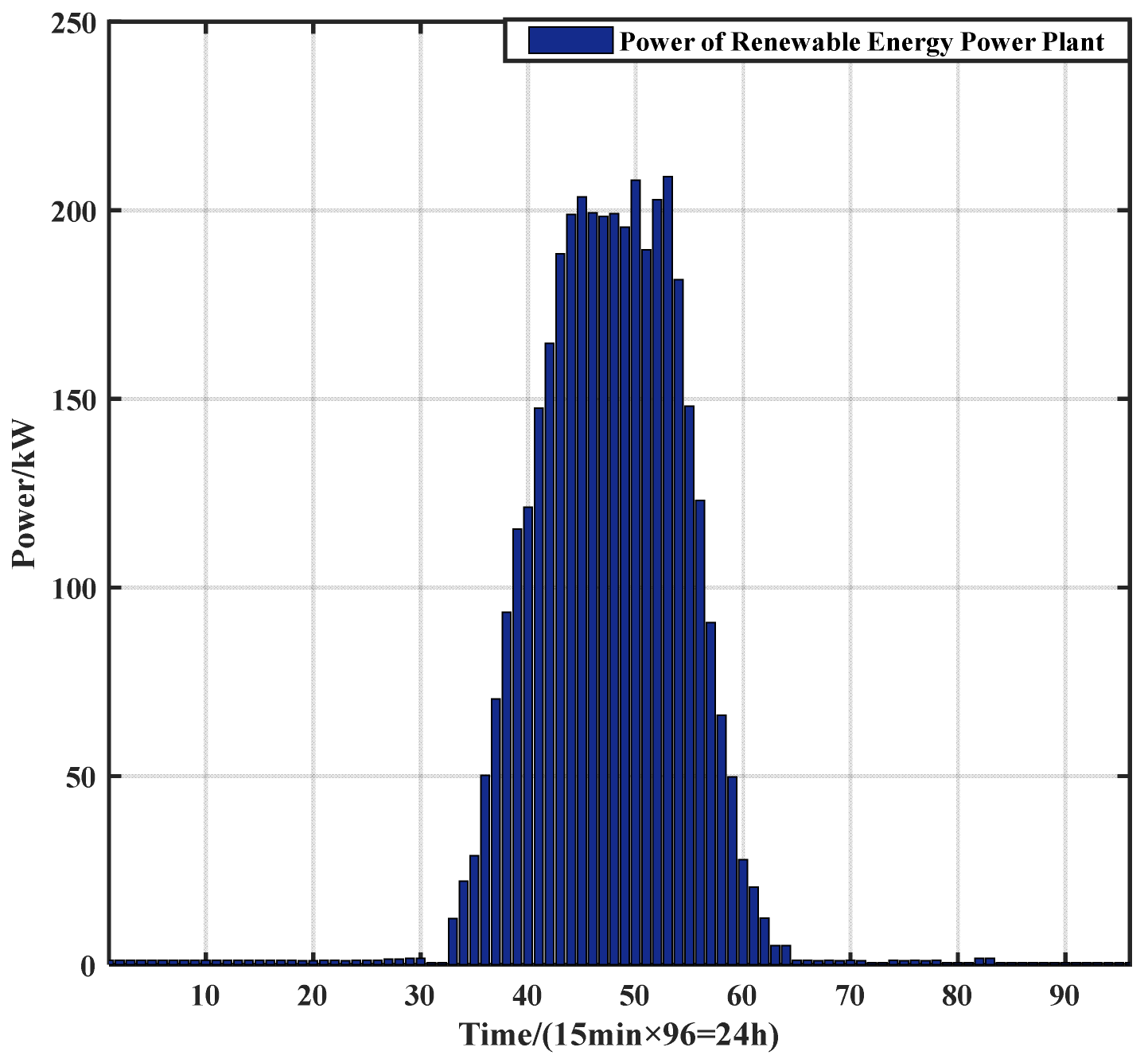
References
- Chih-Lin, I.; Shuangfeng, H.; Sen, B. Energy-efficient 5G for a greener future. Nat. Electron. 2020, 3, 182–184. [Google Scholar]
- Ting, L.; Meng, Z.; Gen, C.; Tao, Z.; Fuchang, L. Research on energy saving technology of 5G base station. Radio Commun. 2020, 5, 46–50. [Google Scholar]
- Huawei. Green 5G: Building a Sustainable World. 2020. Available online: https://www.huawei.com/en/public-policy/green-5g-building-a-sustainable-world (accessed on 20 May 2021).
- Popovic, Z. Amping up the PA for 5G: Efficient GaN power amplifiers with dynamic supplies. IEEE Microw. Mag. 2017, 18, 137–149. [Google Scholar] [CrossRef]
- Wong, J.; Watanabe, N.; Grebennikov, A. High-power high-efficiency broadband GaN HEMT Doherty amplifiers for base station applications. In Proceedings of the 2018 IEEE Topical Conference on RF/Microwave Power Amplifiers for Radio and Wireless Applications (PAWR), Garden Grove, CA, USA, 14–17 January 2018; pp. 16–19. [Google Scholar]
- Sheikh Nijam, A.; Pawan, A.; Joe, B.; Srinivasan, G.; Luke, R.; Deukhyoun, H. A 28GHz 41%-PAE linear CMOS power amplifier using a transformer-based AM-PM distortion-correction technique for 5G phased arrays. In Proceedings of the 2018 IEEE International Solid-State Circuits Conference-(ISSCC), San Francisco, CA, USA, 11–15 February 2018; pp. 406–408. [Google Scholar]
- Hu, S.; Chen, X.; Ni, W.; Wang, X.; Hossain, E. Modeling and Analysis of Energy Harvesting and Smart Grid-Powered Wireless Communication Networks: A Contemporary Survey. IEEE Trans. Green Commun. Netw. 2020, 4, 461–496. [Google Scholar] [CrossRef]
- Israr, A.; Yang, Q.; Li, W.; Zomaya, A.Y. Renewable energy powered sustainable 5G network infrastructure: Opportunities, challenges and perspectives. J. Netw. Comput. Appl. 2021, 175, 102910. [Google Scholar] [CrossRef]
- Berzi, L.; Cultrera, V.; Delogu, M.; Dolfi, M.; Locorotondo, E.; Del Pero, F.; Morosi, S.; Pugi, L.; Tanturli, A. A model for system integration of second life battery, renewable energy generation and mobile network station. In Proceedings of the 2020 IEEE International Conference on Environment and Electrical Engineering and 2020 IEEE Industrial and Commercial Power Systems Europe (EEEIC/I&CPS Europe), Madrid, Spain, 9–12 June 2020; pp. 1–6. [Google Scholar]
- Han, D.; Li, S.; Peng, Y.; Chen, Z. Energy Sharing-Based Energy and User Joint Allocation Method in Heterogeneous Network. IEEE Access 2020, 8, 37077–37086. [Google Scholar] [CrossRef]
- Leithon, J.; Lim, T.J.; Sun, S. Cost-aware renewable energy management with application in cellular networks. IEEE Trans. Green Commun. Netw. 2018, 2, 316–326. [Google Scholar] [CrossRef]
- Zhou, B.; Fang, J.; Ai, X.; Yang, C.; Yao, W.; Wen, J. Dynamic Var Reserve-Constrained Coordinated Scheduling of LCC-HVDC Receiving-End System Considering Contingencies and Wind Uncertainties. IEEE Trans. Sustain. Energy 2021, 12, 469–481. [Google Scholar] [CrossRef]
- Zhou, B.; Ai, X.; Fang, J.; Yao, W.; Zuo, W.; Chen, Z.; Wen, J. Data-adaptive robust unit commitment in the hybrid AC/DC power system. Appl. Energy 2019, 254, 113784. [Google Scholar] [CrossRef]
- Zhou, B.; Ai, X.; Fang, J.; Yao, W.; Wen, J. Continuous-Time Modeling Based Robust Unit Commitment Considering beyond-the-Resolution Wind Power Uncertainty. Trans. China Electrotech. Soc. 2021, 36, 1456–1467. [Google Scholar]
- Checko, A.; Christiansen, H.L.; Yan, Y.; Scolari, L.; Kardaras, G.; Berger, M.S.; Dittmann, L. Cloud RAN for Mobile Networks—A Technology Overview. IEEE Commun. Surv. Tutor. 2015, 17, 405–426. [Google Scholar] [CrossRef] [Green Version]
- Jun, H.; Sen, T.; Shizhuang, Z. Software energy-saving technology for 5G-NR base station. ZTE Technol. J. 2019, 25, 19–23. [Google Scholar]
- Pan, Z.; Zhu, Q. Energy efficiency optimization in 3-D small cell networks-based sleep strategy. IEEE Commun. Lett. 2017, 21, 1131–1134. [Google Scholar] [CrossRef]
- Dutta, U.K.; Razzaque, A.; Al-Wadud, M.A.; Islam, S.; Hossain, M.S.; Gupta, B.B. Self-Adaptive Scheduling of Base Transceiver Stations in Green 5G Networks. IEEE Access 2018, 6, 7958–7969. [Google Scholar] [CrossRef]
- Gandotra, P.; Jha, R.K. A survey on green communication and security challenges in 5G wireless communication networks. J. Netw. Comput. Appl. 2017, 96, 39–61. [Google Scholar] [CrossRef]
- Lau, M.S.K.; Yue, W. Optimality and feasibility of equal power allocation of IDMA systems. In Proceedings of the 2007 5th International Symposium on Modeling and Optimization in Mobile, Ad Hoc and Wireless Networks and Workshops, Limassol, Cyprus, 16–20 April 2007; pp. 1–7. [Google Scholar]
- Yu, W. Multiuser water-filling in the presence of crosstalk. In Proceedings of the 2007 Information Theory and Applications Workshop, San Diego, CA, USA, 29 January–2 February 2007; pp. 414–420. [Google Scholar]
- Evangelinakis, D.I.; Sidiropoulos, N.D.; Swami, A. Joint admission and power control using branch & bound and gradual admissions. In Proceedings of the 2010 IEEE 11th International Workshop on Signal Processing Advances in Wireless Communications (SPAWC), Marrakech, Morocco, 20–23 June 2010; pp. 1–5. [Google Scholar]
- Meshkati, F.; Poor, H.V.; Schwartz, S.C. Energy-efficient resource allocation in wireless networks. IEEE Signal. Process. Mag. 2007, 24, 58–68. [Google Scholar] [CrossRef] [Green Version]
- Fang, F.; Cheng, J.; Ding, Z. Joint energy efficient subchannel and power optimization for a downlink NOMA heterogeneous network. IEEE Trans. Veh. Technol. 2018, 68, 1351–1364. [Google Scholar] [CrossRef]
- Niu, Z.; Wu, Y.; Gong, J.; Yang, Z. Cell zooming for cost-efficient green cellular networks. IEEE Commun. Mag. 2010, 48, 74–79. [Google Scholar] [CrossRef]
- Ghosh, S.; De, D.; Deb, P.; Mukherjee, A. 5G-ZOOM-Game: Small cell zooming using weighted majority cooperative game for energy efficient 5G mobile network. Wirel. Netw. 2018, 26, 349–372. [Google Scholar] [CrossRef]
- Xu, X.; Yuan, C.; Chen, W.; Tao, X.; Sun, Y. Adaptive Cell Zooming and Sleeping for Green Heterogeneous Ultradense Networks. IEEE Trans. Veh. Technol. 2017, 67, 1612–1621. [Google Scholar] [CrossRef]
- Ansari, R.I.; Chrysostomou, C.; Hassan, S.A.; Guizani, M.; Mumtaz, S.; Rodriguez, J.; Rodrigues, J.J.P.C. 5G D2D Networks: Techniques, Challenges, and Future Prospects. IEEE Syst. J. 2018, 12, 3970–3984. [Google Scholar] [CrossRef]
- Lee, N.; Lin, X.; Andrews, J.G.; Heath, R. Power Control for D2D Underlaid Cellular Networks: Modeling, Algorithms, and Analysis. IEEE J. Sel. Areas Commun. 2015, 33, 1–13. [Google Scholar] [CrossRef] [Green Version]
- Björnson, E.; Jorswieck, E.; Debbah, M.; Ottersten, B. Multiobjective Signal Processing Optimization: The way to balance conflicting metrics in 5G systems. IEEE Signal Process. Mag. 2014, 31, 14–23. [Google Scholar] [CrossRef] [Green Version]
- Piunti, P.; Cavdar, C.; Morosi, S.; Teka, K.E.; Del Re, E.; Zander, J. Energy efficient adaptive cellular network configuration with QoS guarantee. In Proceedings of the 2015 IEEE International Conference on Communications (ICC), London, UK, 8–12 June 2015; pp. 68–73. [Google Scholar]
- Jingjin, W.; Yujing, Z.; Moshe, Z.; Edward Kai-Ning, Y. Energy-efficient base-stations sleep-mode techniques in green cellular networks: A survey. IEEE Commun. Surv. Tutor. 2015, 17, 803–826. [Google Scholar]
- Yong, P.; Zhang, N.; Hou, Q.; Liu, Y.; Teng, F.; Ci, S.; Kang, C. Evaluating the Dispatchable Capacity of Base Station Backup Batteries in Distribution Networks. IEEE Trans. Smart Grid 2021, PP, 1. [Google Scholar] [CrossRef]
- Auer, G.; Giannini, V.; Desset, C.; Godor, I.; Skillermark, P.; Olsson, M.; Imran, M.A.; Sabella, D.; Gonzalez, M.J.; Blume, O.; et al. How much energy is needed to run a wireless network? IEEE Wirel. Commun. 2011, 18, 40–49. [Google Scholar] [CrossRef]
- Rahmaniani, R.; Teodor Gabriel, C.; Michel, G.; Walter, R. The Benders decomposition algorithm: A literature review. Eur. J. Oper. Res. 2017, 259, 801–817. [Google Scholar] [CrossRef]
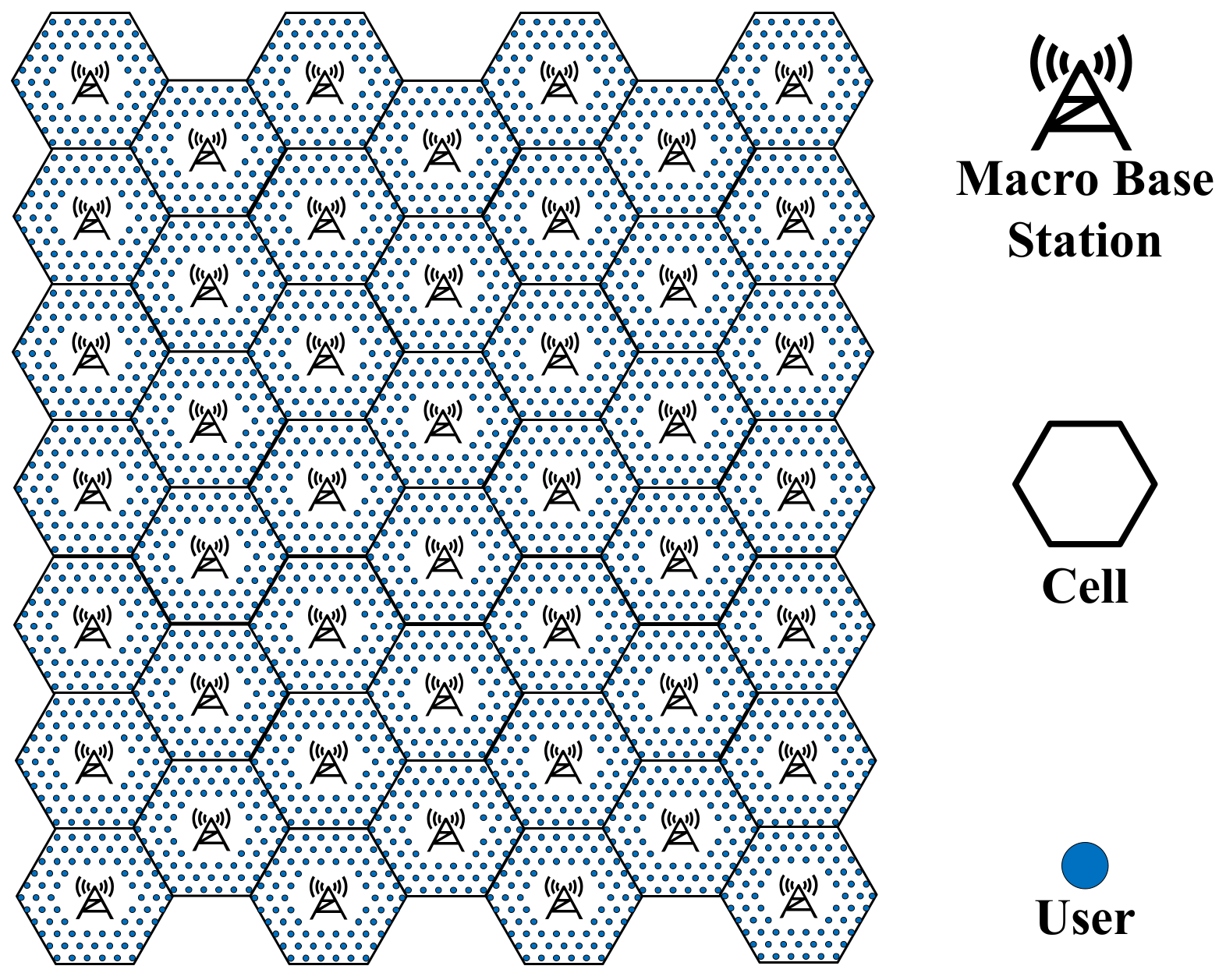
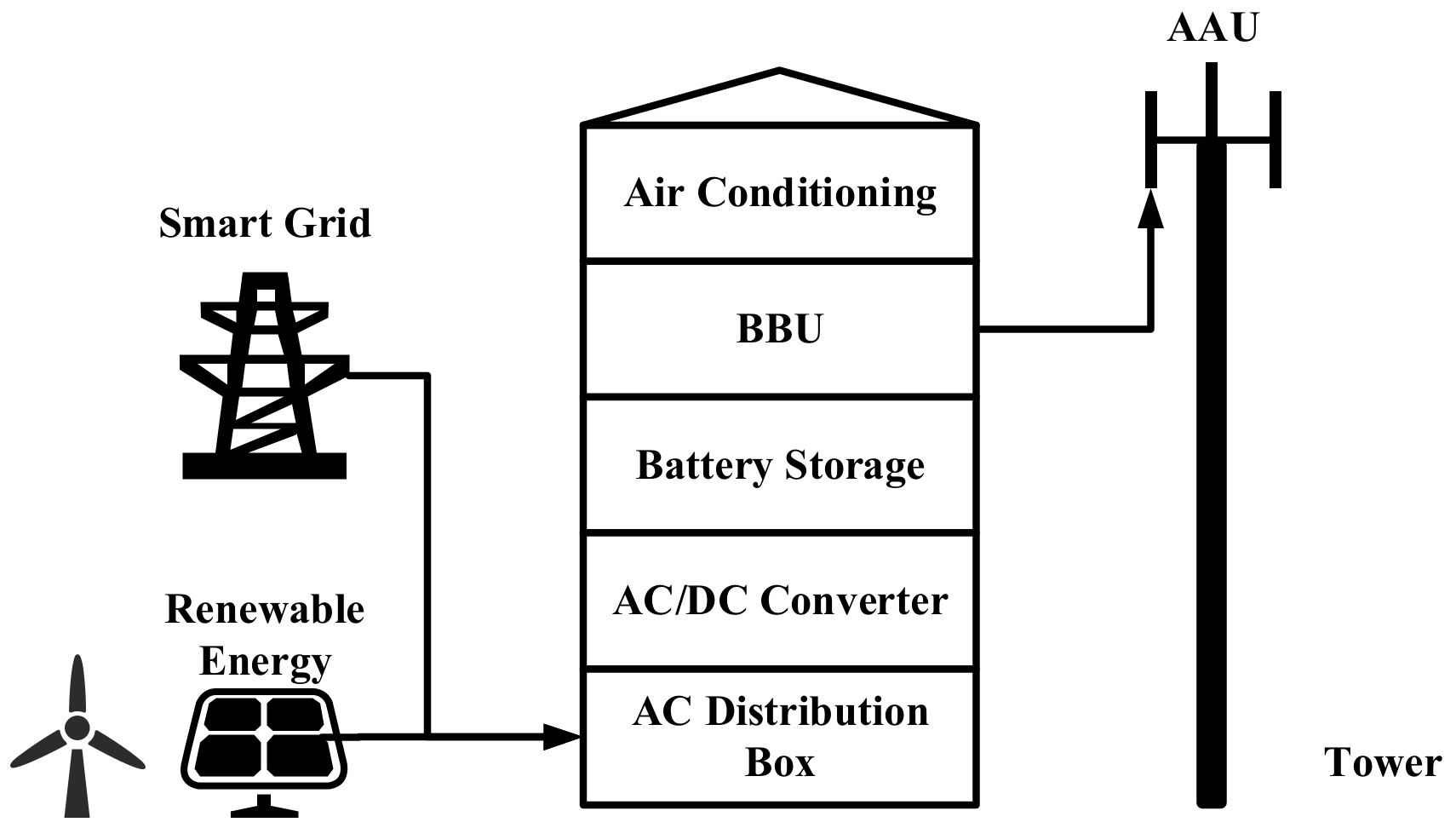
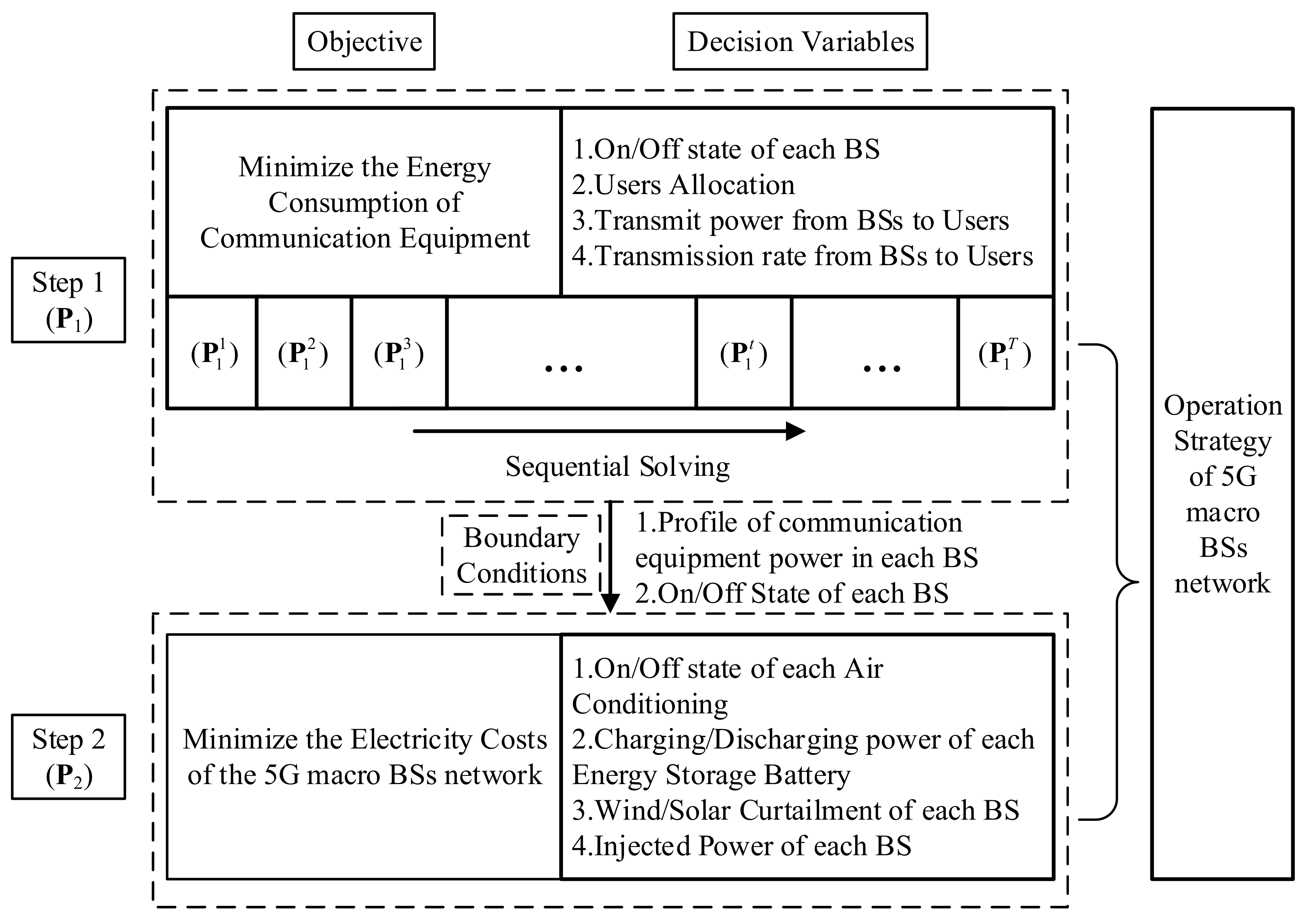


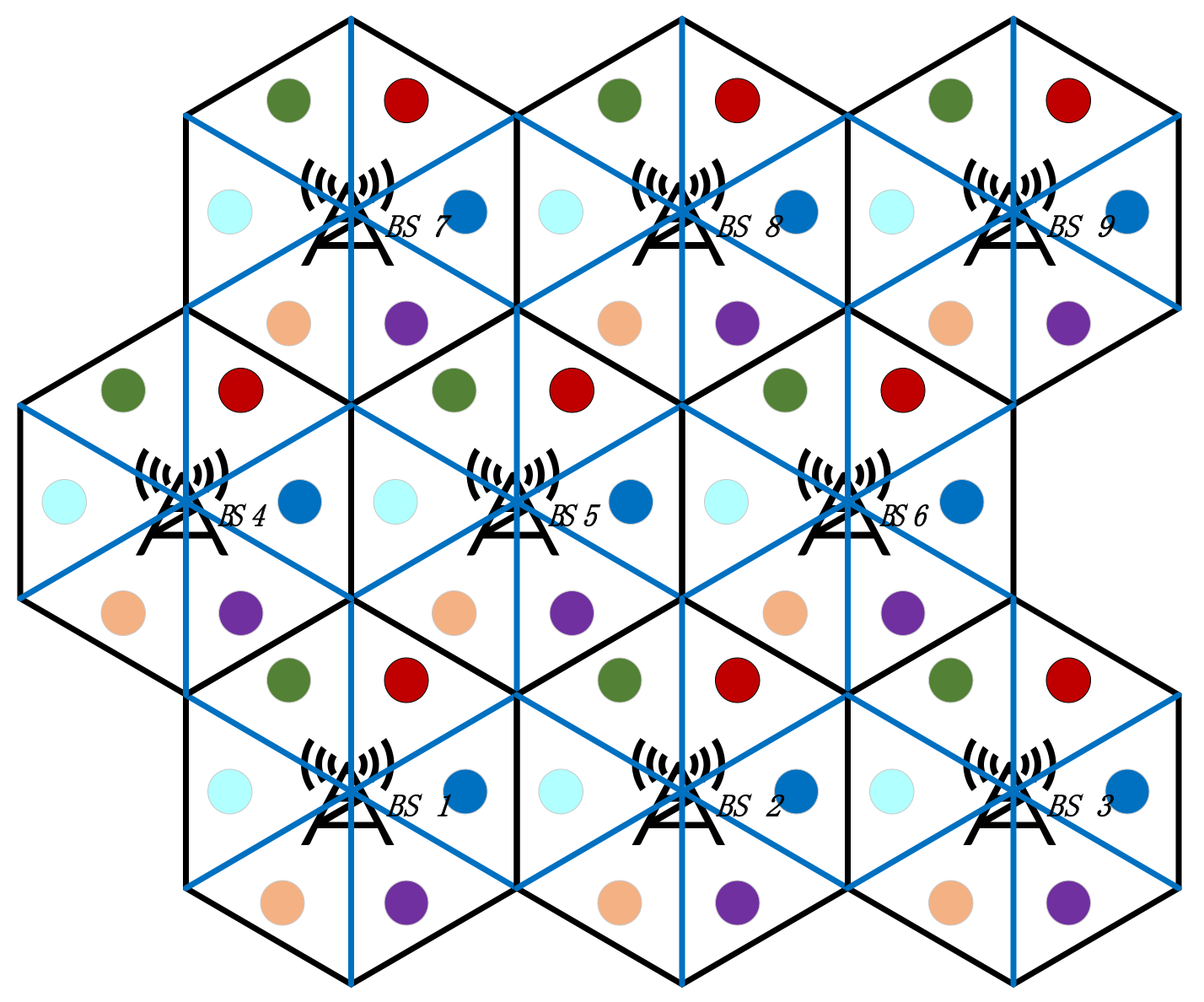

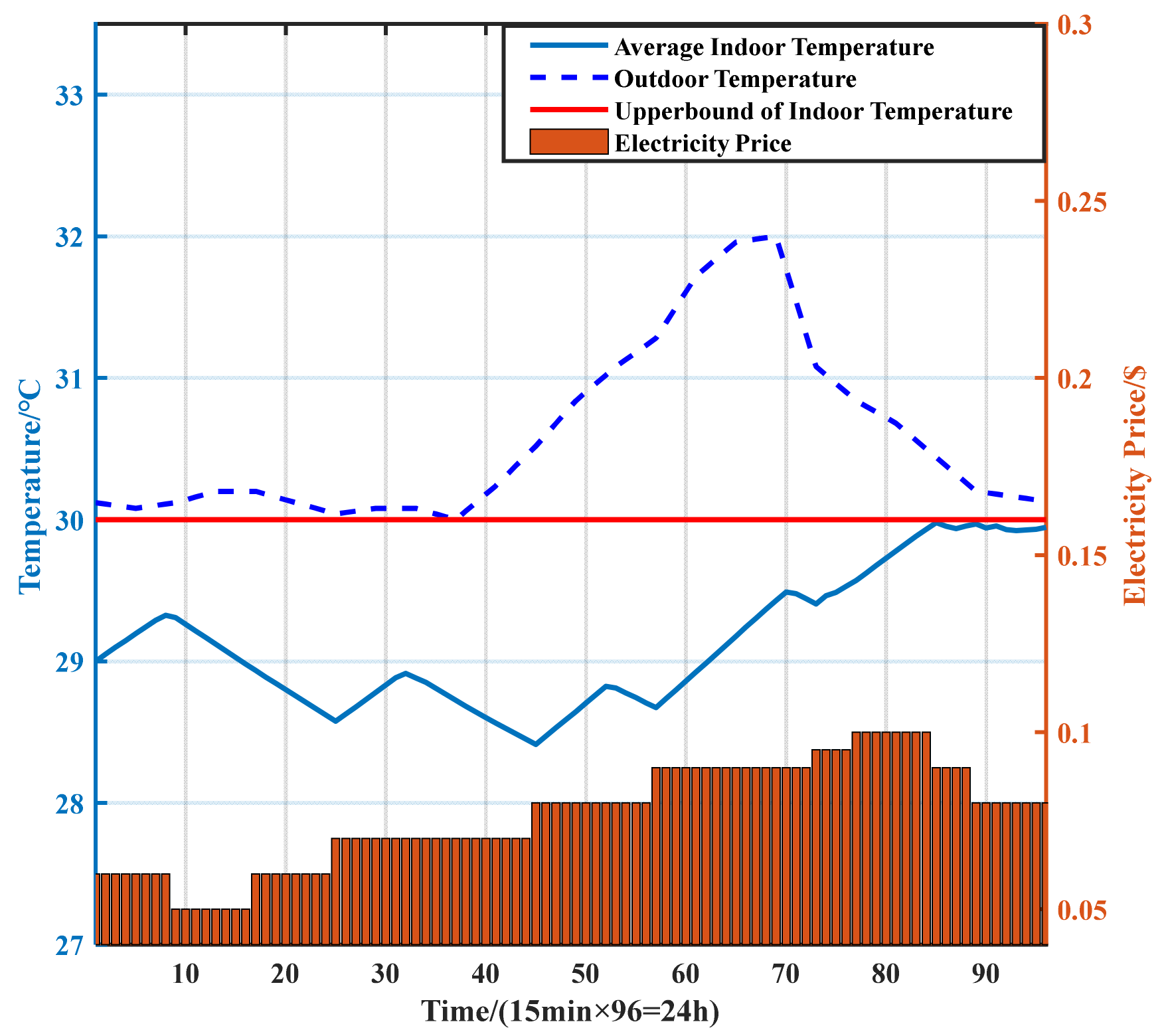


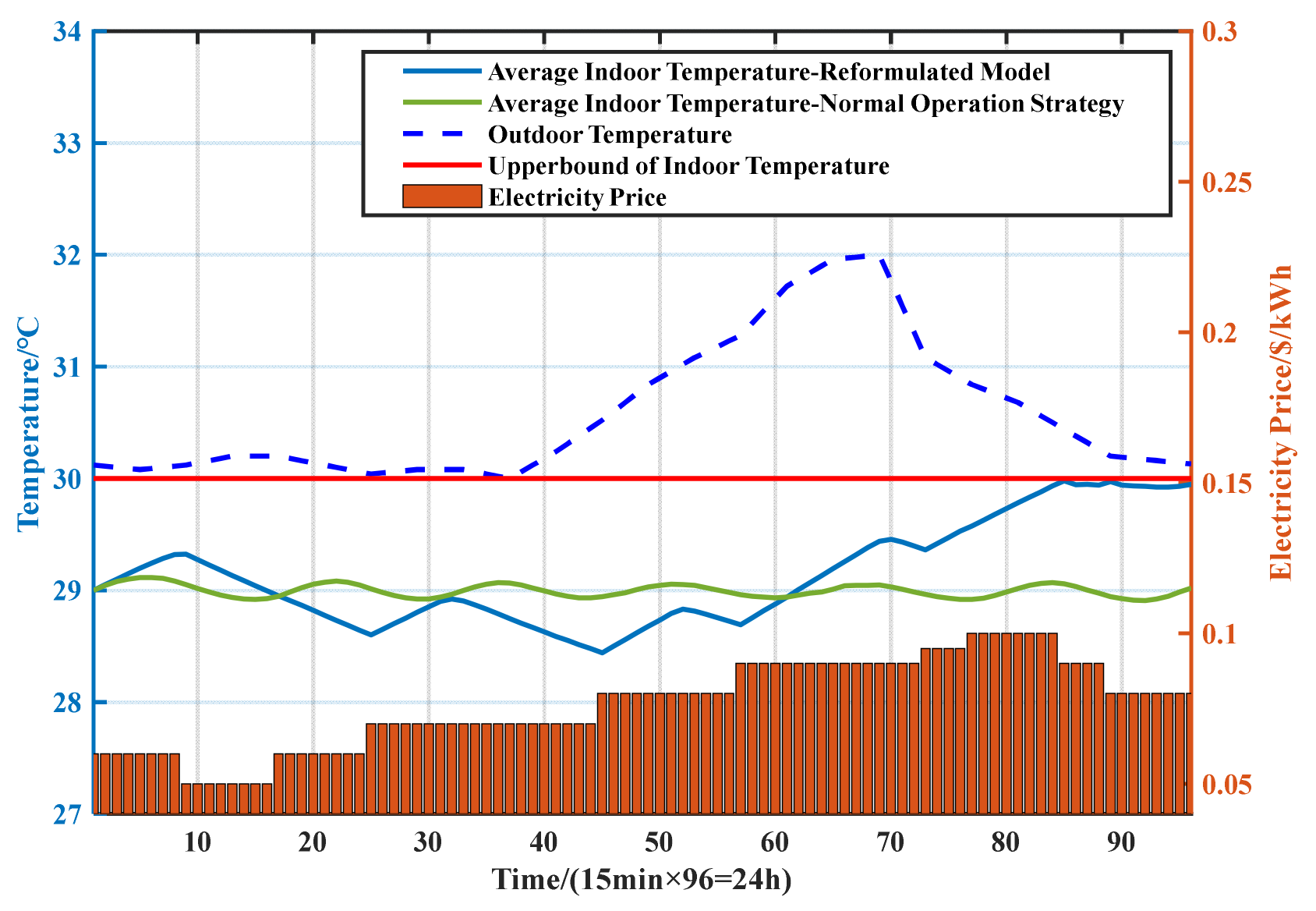

| Case | Objective Value of (P1) (kWh) | Optimality Gap | Calculation Time (s) | Objective Value of (P2) ($) | Optimality Gap | Calculation Time (s) |
|---|---|---|---|---|---|---|
| Case 1 | 588.3 | 0 | 5.3518 | 48.21 | 0 | 582.7 |
| Case 2 | 590.9 | 0.442% | 1.1317 | 48.42 | 0.436% | 469.5 |
| Case 3 | 590.9 | 0.442% | 0.7798 | 48.42 | 0.436% | 40.3 |
| Operation Strategy | Cost/$ | Egrid/kWh | Ecom/kWh | Eair/kWh |
|---|---|---|---|---|
| DS 1 | 693.82 | 9402.29 | 8431.56 | 1651.50 |
| DS 2 | 871.11 | 11,179.75 | 9827.16 | 2305.50 |
Publisher’s Note: MDPI stays neutral with regard to jurisdictional claims in published maps and institutional affiliations. |
© 2021 by the authors. Licensee MDPI, Basel, Switzerland. This article is an open access article distributed under the terms and conditions of the Creative Commons Attribution (CC BY) license (https://creativecommons.org/licenses/by/4.0/).
Share and Cite
Li, K.; Ai, X.; Fang, J.; Zhou, B.; Le, L.; Wen, J. Coordination of Macro Base Stations for 5G Network with User Clustering. Sensors 2021, 21, 5501. https://doi.org/10.3390/s21165501
Li K, Ai X, Fang J, Zhou B, Le L, Wen J. Coordination of Macro Base Stations for 5G Network with User Clustering. Sensors. 2021; 21(16):5501. https://doi.org/10.3390/s21165501
Chicago/Turabian StyleLi, Kun, Xiaomeng Ai, Jiakun Fang, Bo Zhou, Lingling Le, and Jinyu Wen. 2021. "Coordination of Macro Base Stations for 5G Network with User Clustering" Sensors 21, no. 16: 5501. https://doi.org/10.3390/s21165501
APA StyleLi, K., Ai, X., Fang, J., Zhou, B., Le, L., & Wen, J. (2021). Coordination of Macro Base Stations for 5G Network with User Clustering. Sensors, 21(16), 5501. https://doi.org/10.3390/s21165501







